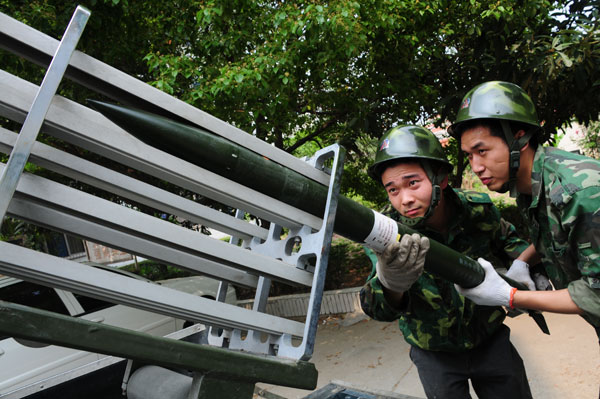Society
Seven months' drought in Hubei comes to a halt
By Guo Rui (China Daily)
Updated: 2011-05-11 07:57
 |
Large Medium Small |
 Two workers with the meteorological authority in Xiangyang city, Hubei province, load a rocket, which contains chemicals that spur precipitation, in this undated photo. [Xu Hui/China Daily] |
XIANGYANG, Hubei - Standing in the rain, Zhang Dequn, could not be happier.
After seven months of drought, it finally started raining again on Tuesday.
The rain means the 45-year-old farmer and his wife have been busy planting sweet potato seedlings since the early morning.
"During the drought, we only planted a little sweet potato in the field, but this rain has brought hope for us," Zhang said.
| ||||
According to the local meteorological bureau, Xiangyang implemented artificial precipitation measures to bring an end to the most serious drought it has suffered in the past 50 years,
"Starting from 3 am on Tuesday, we launched 57 rocket projectiles and 320 artillery projectiles." said Xu Zhaonan, director of the Xiangyang meteorological bureau.
Although the artificial precipitation relieved the current dryness, there will be no rain in the next ten days, Xu said.
Until Monday, the drought had affected 300,000 hectares in Xiangyang, equal to 70 percent of the city's crop-growing area, and around a third of them suffered severe drought.
The drought also meant some 250,000 residents faced drinking water shortages.
Data reveal that from October 2010 to April 2011, the accumulative precipitation in the city was about 125 millimeters, 50 percent less than usual.
Facing serious aridity, the city substantially increased investment to combat it.
"We employed 346,700 people and 1,435 pumping stations to fight the drought, with a total investment of 56.6 million yuan ($8.7 million)," Gong Hongjing, an official with Xiangyang flood control and drought relief office, said.
Besides Xiangyang, most cities in Hubei provinces had rain on Tuesday.
Until Monday, the aquaculture industry of Hubei province suffered more than 2 billion yuan in economic losses due to the drought.
| 分享按钮 |



